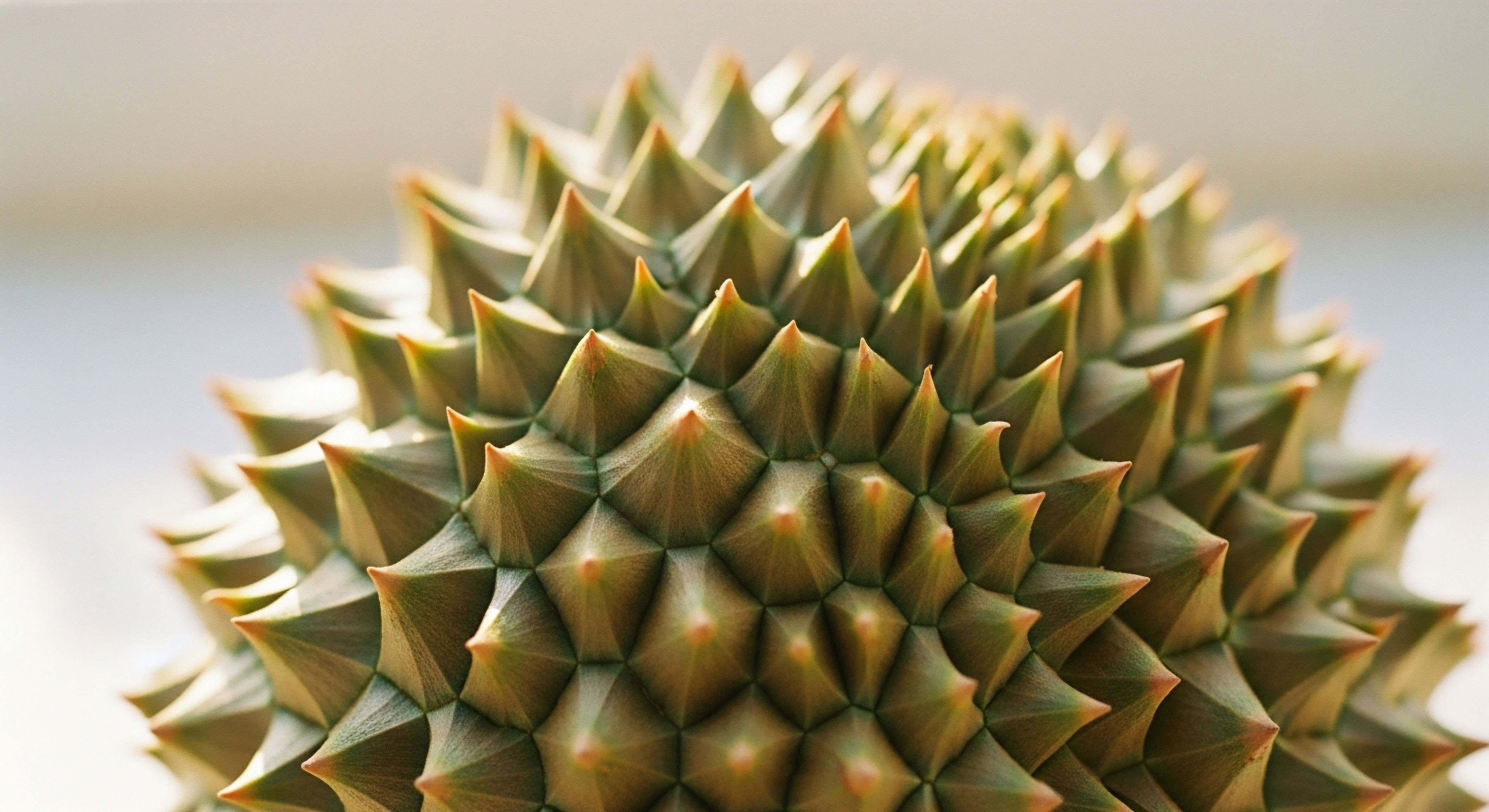

Fundamentals
You feel it as a dull ache in a joint that never quite recovered, or the frustrating realization that your body takes longer to bounce back than it once did. These experiences are data points. They are your body’s method of communicating a change in its internal environment, a shift in its capacity for maintenance and repair.
This conversation between you and your physiology is where the science of regenerative peptides begins. Understanding these sophisticated biological tools is a personal journey into your own systems, aimed at reclaiming vitality and function.
Peptides are short chains of amino acids, which are the fundamental building blocks of proteins. Your body naturally produces thousands of different peptides, each with a highly specific role. They function as signaling molecules, carrying precise instructions from one cell to another. Think of them as expert project managers within a vast construction site.
One might be tasked with directing inflammation, another with laying down new structural materials like collagen, and a third with coordinating the growth of new blood vessels to supply the area with resources. The process of healing is a complex, beautifully orchestrated sequence of events, and peptides are the conductors of this symphony.

The Blueprint for Bodily Repair
Tissue regeneration unfolds in distinct phases. Initially, an acute inflammatory response is necessary to clear out damaged cells and debris. Following this cleanup phase, the body enters a proliferative stage, where new tissue is actively built.
This involves creating a new extracellular matrix, a scaffold of collagen and other proteins, and developing new blood vessels to nourish the site, a process known as angiogenesis. Finally, the remodeling phase begins, where the newly formed tissue is refined and strengthened over time, gradually restoring its original function and resilience. When this process is slow or incomplete, lingering symptoms and functional limitations can result.
Certain peptides have been identified for their ability to specifically support one or more of these critical phases. They do not introduce a foreign process to the body. Instead, they amplify the body’s own inherent healing commands, providing a clear and powerful signal in areas where the natural communication may have become muted due to age, chronic stress, or significant injury. This targeted support is the foundation of using peptide protocols to enhance tissue regeneration.
A peptide is a biological messenger that directs specific cellular actions, forming the basis of the body’s own repair mechanisms.

Introducing Key Regenerative Peptides
To understand their application, consider two distinct examples. Body Protection Compound 157 (BPC-157) is a peptide that has garnered significant attention for its profound effects on localized tissue repair. Derived from a protein found in human gastric juice, it appears to act as a general contractor for healing, accelerating the repair of tendons, ligaments, muscle, and even the lining of the gastrointestinal tract.
Its primary role involves promoting the outgrowth of fibroblasts ∞ the cells responsible for creating connective tissue ∞ and enhancing the formation of new blood vessels directly at the site of injury.
Another well-studied peptide is GHK-Cu, a tripeptide complexed with a copper ion. Naturally present in human plasma, its concentration declines significantly with age. GHK-Cu has demonstrated powerful effects on skin and soft tissue remodeling. It stimulates the synthesis of collagen and other key components of the skin’s structural matrix, while also providing antioxidant and anti-inflammatory support.
This makes it a valuable agent in wound healing and skin regeneration protocols, working to restore the integrity and function of the body’s largest organ.

How Are Peptides Administered for Healing?
The method of delivery for a peptide is determined by its intended target. For an injury in a specific location, such as a damaged tendon in the shoulder, a localized subcutaneous injection near the site can deliver a high concentration of a peptide like BPC-157 directly where it is needed most.
For more systemic goals, such as elevating the body’s overall repair capacity, other peptides are used that influence the endocrine system on a broader scale. Oral and intra-articular routes also have specific applications, though they present challenges with bioavailability and degradation. The selection of a peptide and its route of administration is a clinical decision based on the specific tissue involved and the desired biological outcome.


Intermediate
Moving beyond foundational concepts requires a closer examination of the precise mechanisms through which specific peptides exert their regenerative effects. These molecules are not blunt instruments; they are highly selective keys designed to fit specific molecular locks. Their therapeutic value comes from this precision, allowing for targeted interventions that support the body’s healing architecture.
Understanding these pathways illuminates how protocols are designed to address everything from a nagging sports injury to the systemic decline in vitality associated with hormonal shifts.

The Cellular Mechanics of BPC-157
BPC-157’s reputation as a potent healing agent is grounded in its multi-faceted influence on cellular behavior at an injury site. Its primary mechanism is the promotion of angiogenesis, the formation of new blood vessels. It achieves this by upregulating key growth factors, most notably Vascular Endothelial Growth Factor (VEGF).
An injury site is metabolically demanding, and a robust network of capillaries is essential for delivering oxygen, nutrients, and reparative cells. BPC-157 appears to significantly accelerate the development of this critical infrastructure.
Furthermore, BPC-157 has a direct effect on tendon fibroblasts, the cells responsible for producing collagen and repairing ligaments and tendons. Research indicates that it promotes the survival and migration of these fibroblasts, effectively marshalling the workforce needed to rebuild damaged connective tissue.
It influences the FAK-paxillin pathway, a critical signaling cascade for cellular adhesion and movement, which helps fibroblasts navigate to and anchor within the damaged area to begin their work. This peptide also demonstrates a powerful ability to protect cells from various forms of stress, a property known as cytoprotection, which helps preserve healthy tissue at the margins of an injury.

Harnessing the Growth Hormone Axis for Systemic Repair
While BPC-157 is a specialist in localized repair, other peptides work more broadly by modulating the body’s master regenerative system ∞ the Growth Hormone (GH) axis. The pituitary gland releases GH in pulses, which then travels to the liver and other tissues, prompting the production of Insulin-Like Growth Factor 1 (IGF-1).
Both GH and IGF-1 are profoundly anabolic, meaning they promote the building of tissues, including muscle and bone. They are central to the body’s ability to recover from physical stress and maintain metabolic health. As we age, the amplitude and frequency of these GH pulses naturally decline, contributing to slower recovery, loss of muscle mass, and increased body fat.
Protocols using Growth Hormone secretagogues are designed to restore a more youthful pulse pattern, thereby enhancing the body’s systemic capacity for tissue maintenance and repair.

The Synergy of Ipamorelin and CJC-1295
Peptide therapy often uses a synergistic approach to stimulate the GH axis. This is exemplified by the combination of Ipamorelin and CJC-1295. These two peptides work on different parts of the pituitary’s control system to amplify GH release in a way that mimics the body’s natural patterns.
- CJC-1295 is a Growth Hormone-Releasing Hormone (GHRH) analogue. It binds to GHRH receptors in the pituitary gland, signaling it to produce and release more GH. Its chemical structure is modified to give it a longer half-life, allowing it to create a sustained, elevated baseline of GH release potential.
- Ipamorelin is a Growth Hormone-Releasing Peptide (GHRP), also known as a ghrelin mimetic. It binds to a different receptor in the pituitary (the GHS-R1a receptor) and stimulates a strong, clean pulse of GH release. It is highly selective, meaning it prompts this GH pulse without significantly affecting other hormones like cortisol or prolactin, which can have undesirable side effects.
When used together, CJC-1295 raises the water level in the reservoir, and Ipamorelin opens the floodgates. This combination results in a powerful yet physiologically controlled release of GH, leading to increased IGF-1 levels. The clinical benefits include enhanced muscle protein synthesis, accelerated recovery from exercise, improved lipolysis (fat breakdown), and better sleep quality, all of which are foundational for effective tissue regeneration.

What Are the Distinctions in Growth Hormone Peptide Protocols?
Different peptides that stimulate the GH axis have unique properties and applications. The choice of peptide depends on the specific clinical goal, whether it is generalized anti-aging and recovery or targeting a specific metabolic issue.
| Peptide Protocol | Primary Mechanism of Action | Key Clinical Application |
|---|---|---|
| Ipamorelin / CJC-1295 | Synergistic GHRH and GHRP stimulation, creating strong, natural GH pulses. | General anti-aging, muscle gain, fat loss, and improved recovery and sleep. |
| Tesamorelin | A potent GHRH analogue, specifically studied for its metabolic effects. | Targeted reduction of visceral adipose tissue (VAT) and improving metabolic markers. |
| Sermorelin | An earlier GHRH analogue with a shorter half-life, requiring more frequent administration. | Used for restoring a more natural GH rhythm, often for anti-aging purposes. |


Academic
A sophisticated understanding of peptide therapy for tissue regeneration requires a systems-biology perspective, moving from the action of a single peptide to the interplay of multiple signaling networks. The process of healing is fundamentally dependent on vascularity. Without robust blood flow, no therapeutic agent can be effective.
Therefore, a deep exploration of how specific peptides modulate the interconnected pathways of angiogenesis and endothelial function provides a unifying framework for understanding their regenerative potential, connecting localized repair agents like BPC-157 with systemic modulators of the GH/IGF-1 axis.

The VEGFR2 Signaling Cascade as a Central Healing Hub
The master regulator of angiogenesis is Vascular Endothelial Growth Factor A (VEGF-A), which exerts its effects by binding to its primary receptor, VEGFR2, on the surface of endothelial cells ∞ the cells that form the inner lining of blood vessels. The activation of VEGFR2 initiates a cascade of intracellular events that are critical for healing. BPC-157 has been shown in preclinical models to directly and potently influence this hub.
Studies demonstrate that BPC-157 administration leads to an upregulation of VEGFR2 expression on endothelial cells. This effectively makes the cells more sensitive to the pro-angiogenic signals present in the environment. Upon binding VEGF-A, the activated VEGFR2 receptor triggers the phosphorylation of downstream protein kinases, most notably Akt and endothelial Nitric Oxide Synthase (eNOS).
The activation of the VEGFR2-Akt-eNOS signaling pathway is a pivotal event. Activated eNOS produces nitric oxide (NO), a powerful vasodilator that increases local blood flow and permeability. This process is essential for allowing plasma proteins and immune cells to access the injury site.
Furthermore, the signaling cascade promotes endothelial cell survival, proliferation, and migration, which are the cellular processes required to build new capillary networks into damaged tissue. BPC-157’s ability to positively modulate this entire pathway explains its remarkable efficacy in accelerating wound healing and restoring blood flow in ischemic tissues.

Systemic Hormonal Influence on Vascular Health
The GH/IGF-1 axis, stimulated by peptides like Tesamorelin or the Ipamorelin/CJC-1295 combination, also converges on this vascular network, albeit through a more systemic and sustained mechanism. Both GH and IGF-1 have direct, beneficial effects on the cardiovascular system. They promote endothelial cell health and function, in part by also stimulating nitric oxide production. A healthy endothelium is more responsive and capable of participating in the angiogenic processes required for repair.
Tesamorelin, for instance, has been shown to enhance tissue repair and wound healing by promoting angiogenesis and increasing collagen production. This effect is mediated by the systemic elevation of GH and subsequently IGF-1. Elevated IGF-1 levels support the proliferation of endothelial cells and smooth muscle cells, which are necessary for building and stabilizing new blood vessels.
Therefore, while BPC-157 acts as a direct, localized amplifier of the VEGFR2 pathway, GH secretagogues create a permissive systemic environment where the entire vascular system is better primed to respond to angiogenic signals. This dual approach ∞ enhancing both the local signal and the systemic response capacity ∞ represents a sophisticated clinical strategy.
The convergence of local peptide action and systemic hormonal optimization on the VEGFR2-Akt-eNOS pathway provides a powerful, unified model for advanced tissue regeneration.

How Does This Integrated Approach Inform Clinical Strategy?
Understanding this convergence allows for the development of highly rational, multi-layered therapeutic protocols. An athlete with a chronic Achilles tendinopathy presents a classic case. The pathology involves degenerated tissue with poor vascularity, which is why it fails to heal properly. A protocol could be designed to address this from multiple angles.
| Therapeutic Layer | Peptide Agent(s) | Biological Rationale |
|---|---|---|
| Local Repair Signal | BPC-157 | Administered subcutaneously near the Achilles tendon to directly upregulate VEGFR2 and stimulate local angiogenesis and fibroblast migration. |
| Systemic Anabolic Support | Ipamorelin / CJC-1295 | Administered systemically to restore youthful GH/IGF-1 levels, enhancing overall protein synthesis and improving the health and responsiveness of the vascular endothelium. |
| Connective Tissue Matrix | GHK-Cu (Topical/Local) | Can be considered to support the quality of collagen being produced and to provide additional anti-inflammatory and antioxidant effects at the tissue level. |
This integrated model views tissue regeneration not as a singular event to be triggered, but as a complex biological system to be optimized. It acknowledges that true healing requires both a powerful, direct signal at the site of damage and a systemically healthy and responsive physiological environment. Future research will likely continue to refine these combination protocols, potentially incorporating other peptides that modulate inflammation or stem cell activity, further enhancing the precision and efficacy of regenerative medicine.

References
- Cushman, Lee J. et al. “Local and Systemic Peptide Therapies for Soft Tissue Regeneration ∞ A Narrative Review.” Yale Journal of Biology and Medicine, vol. 97, no. 3, 2024, pp. 395-408.
- Hsieh, Ming-Jai, et al. “Therapeutic potential of pro-angiogenic BPC157 is associated with VEGFR2 activation and up-regulation.” Journal of Molecular Medicine, vol. 95, no. 6, 2017, pp. 623-633.
- Seo, S. et al. “BPC 157 enhances the expression of vascular endothelial growth factor (VEGF) in human umbilical vein endothelial cells (HUVECs).” Journal of Pharmacological Sciences, vol. 148, no. 1, 2022, pp. 88-95.
- Sigalos, J. T. and A. W. Pastuszak. “The Safety and Efficacy of Growth Hormone Secretagogues.” Sexual Medicine Reviews, vol. 6, no. 1, 2018, pp. 45-53.
- Pickart, Loren, and Anna Margolina. “Regenerative and Protective Actions of the GHK-Cu Peptide in the Light of the New Gene Data.” International Journal of Molecular Sciences, vol. 19, no. 7, 2018, p. 1987.
- Sattler, F. R. et al. “Effects of tesamorelin on body composition and visceral fat in HIV-infected patients with abdominal fat accumulation ∞ a randomized, double-blind, placebo-controlled trial.” The Journal of Clinical Endocrinology & Metabolism, vol. 94, no. 6, 2009, pp. 1994-2004.
- Chang, Chih-Hao, et al. “The promoting effect of pentadecapeptide BPC 157 on tendon healing involves tendon outgrowth, cell survival, and cell migration.” Journal of Applied Physiology, vol. 110, no. 3, 2011, pp. 774-780.
- Sinha, D. K. et al. “Beyond the androgen receptor ∞ the role of growth hormone secretagogues in the modern management of body composition in hypogonadal males.” Translational Andrology and Urology, vol. 9, suppl. 2, 2020, pp. S149-S159.

Reflection

A Dialogue with Your Biology
The information presented here represents a detailed map of specific biological pathways. This knowledge is a powerful tool. It transforms the abstract feeling of being unwell or slow to heal into a set of understandable, and potentially modifiable, physiological processes. Your body is constantly communicating its status and its needs through the symptoms you experience.
The sensation of a weak joint or persistent fatigue is not a personal failing; it is a request for support, a signal that the internal systems of maintenance and repair may require specific resources to function optimally.
This journey into understanding your own endocrine and metabolic function is deeply personal. The science provides the vocabulary, but you are the expert on your own lived experience. Contemplating this information is an opportunity to reframe your relationship with your body, viewing it as a complex, intelligent system you can partner with.
The path forward involves listening to its signals with greater clarity and considering how targeted, evidence-based interventions might help restore its innate capacity for healing, resilience, and vitality.



